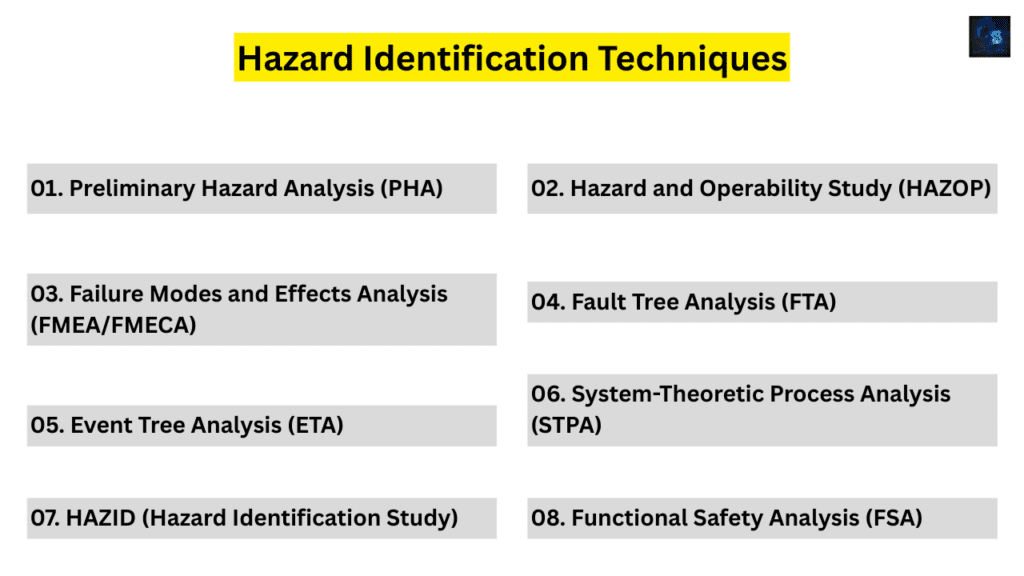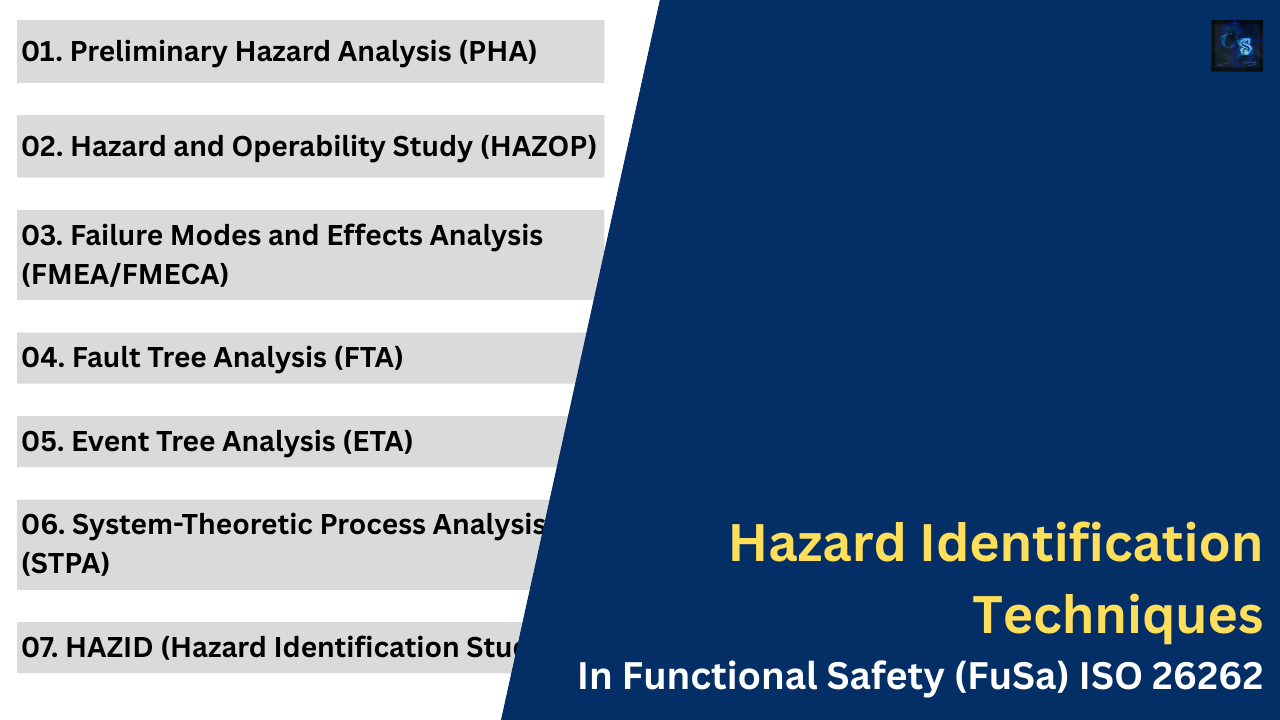Hazard Identification Techniques In Functional Safety (FuSa) ISO 26262
Hello guys, welcome back to our blog. In this article, I will discuss hazard identification techniques in functional safety (FuSa) ISO26262, and comparing hazard identification techniques.
Ask questions if you have any electrical, electronics, or computer science doubts. You can also catch me on Instagram – CS Electrical & Electronics
- Troubleshooting CAN Communication Failures In A Test Environment
- Code Generation In MATLAB Simulink, Things To Be Followed For Efficient Code Generation
- Variable-Step Solvers In MATLAB Simulink: Which One To Select
Hazard Identification Techniques In Functional Safety (FuSa) ISO 26262
Functional Safety (FuSa) plays a critical role in ensuring that electronic and electrical (E/E) systems operate safely even under failure conditions. Hazard identification is a fundamental step in the safety lifecycle, helping to detect potential risks early in the development process.
With the increasing complexity of modern systems, especially in automotive, aerospace, and industrial automation, rigorous hazard identification techniques are necessary to prevent catastrophic failures. This article explores various methods used for hazard identification in FuSa, emphasizing their applications, advantages, and limitations.
Basics of Hazard Identification
Hazard identification is the process of systematically recognizing potential hazards that could compromise system safety.
Key Definitions:
- Hazard: A potential source of harm
- Risk: The probability and severity of a hazard leading to an accident
- Safety Goal: A high-level requirement ensuring hazard mitigation
Role of Hazard Identification in FuSa
Hazard identification occurs early in the safety lifecycle and continues throughout the system’s development. It informs risk assessment, system design, and safety validation, ensuring compliance with standards such as ISO 26262 (Automotive) and IEC 61508 (General Industrial Safety).
Common Challenges in Hazard Identification
- Increasing system complexity
- Emerging risks from AI and automation
- Integration of multiple hazard identification techniques
Key Hazard Identification Techniques
Hazard identification techniques are essential for recognizing potential risks in systems and ensuring that appropriate safety measures are implemented. These techniques vary in complexity and application, depending on the industry and the nature of the system being analyzed. Some methods focus on early-stage risk detection, while others provide detailed, quantitative assessments of potential failures. Combining multiple techniques often leads to a more comprehensive safety evaluation.
Each technique has its strengths and weaknesses, and their effectiveness depends on factors such as system complexity, available data, and regulatory requirements. While a Preliminary Hazard Analysis (PHA) is useful for identifying risks early in the design phase, techniques like Failure Modes and Effects Analysis (FMEA) and Fault Tree Analysis (FTA) provide structured methodologies for analyzing specific failure scenarios. Additionally, modern methods such as System-Theoretic Process Analysis (STPA) are increasingly being used in complex software-driven systems.
The choice of technique depends on the nature of the system being analyzed, the available data, and the regulatory requirements that need to be met. Below are the key hazard identification techniques, along with their methodologies, benefits, and limitations.

01. Preliminary Hazard Analysis (PHA)
Overview: PHA is a qualitative technique used to identify hazards at an early stage of system development. It provides an initial risk assessment before detailed design and development take place.
Process:
- Define system boundaries and operational conditions
- Identify potential hazards and failure scenarios
- Assess risks based on likelihood and severity
- Recommend high-level mitigation strategies
Pros: Quick, cost-effective, helps in early decision-making
Cons: Limited depth, requires further analysis using advanced methods
02. Hazard and Operability Study (HAZOP)
Overview: HAZOP is a structured technique that systematically evaluates deviations from the intended system operation and their potential hazards.
Process:
- Define the system and key operating parameters
- Identify deviations (e.g., too high, too low, missing, incorrect)
- Analyze potential safety consequences and recommend corrective measures
Pros: Effective for complex systems, ensures detailed risk analysis
Cons: Requires significant time and expertise, may not be applicable to all systems
03. Failure Modes and Effects Analysis (FMEA/FMECA)
Overview: FMEA is a bottom-up approach that systematically identifies failure modes and assesses their impact on the system.
Types:
- Design FMEA (DFMEA): Focuses on design-related failures
- Process FMEA (PFMEA): Examines failures in manufacturing or operational processes
Process:
- Identify failure modes for each component
- Analyze failure effects and assign risk priority numbers (RPN)
- Recommend mitigation strategies
Pros: Structured, preventive approach, widely used
Cons: Time-consuming, subject to human error
04. Fault Tree Analysis (FTA)
Overview: FTA is a deductive (top-down) approach that examines potential causes of a system failure using logical diagrams.
Process:
- Define the top-level failure event
- Identify contributing causes using Boolean logic (AND, OR gates)
- Quantify probabilities of failure events
Pros: Effective for complex systems, provides a clear visual representation
Cons: Requires deep system knowledge, complex for large systems
05. Event Tree Analysis (ETA)
Overview: ETA assesses the possible outcomes of an initiating event by evaluating different response pathways.
Process:
- Define the initiating event (e.g., system failure, external event)
- Map out potential outcomes and their probabilities
- Evaluate consequences and recommend risk reduction measures
Pros: Ideal for emergency response planning and risk assessment
Cons: Requires accurate probability data, limited scope
06. System-Theoretic Process Analysis (STPA)
Overview: STPA is a modern approach that focuses on identifying unsafe control actions in complex, software-driven systems.
Process:
- Define the control structure of the system
- Identify unsafe control actions and failure scenarios
- Analyze causal factors and recommend safety measures
Pros: Effective for AI-based and automated systems, considers human interaction
Cons: Requires deep knowledge of system architecture, time-intensive
07. HAZID (Hazard Identification Study)
Overview: HAZID is a qualitative study that identifies hazards at an early stage through brainstorming and expert discussions.
Process:
- Define system scope and operational environment
- Brainstorm potential hazards and failure modes
- Categorize and prioritize risks for further analysis
Pros: Flexible, collaborative, applicable to various industries
Cons: Subjective, lacks quantitative assessment
08. Functional Safety Analysis (FSA)
Overview: FSA evaluates whether functional safety requirements are adequately implemented and maintained.
Process:
- Review system safety goals and compliance with standards
- Validate implementation of safety functions
- Conduct audits and continuous monitoring
Pros: Ensures compliance with safety standards, provides structured safety validation
Cons: Requires extensive documentation and verification
Comparing Hazard Identification Techniques
| Technique | Strengths | Weaknesses |
| PHA | Quick, early identification | Lacks detailed analysis |
| HAZOP | Structured, effective for complex systems | Time-consuming |
| FMEA | Preventive, quantitative | Prone to human error |
| FTA | Identifies failure paths | Complex |
| ETA | Risk assessment focused | Needs accurate data |
| STPA | Effective for AI-driven systems | Requires deep understanding |
| HAZID | Flexible, collaborative | Subjective judgment |
| FSA | Ensures compliance | Documentation-heavy |
Case Studies and Industry Applications
- Automotive (ISO 26262): Using FMEA and FTA in ADAS safety assessment
- Aerospace (DO-178C): STPA for autonomous flight control systems
- Industrial Automation: HAZOP in chemical plant safety design
Conclusion
Hazard identification is a critical component of Functional Safety, ensuring that safety risks are mitigated early in the development lifecycle. Implementing rigorous techniques like PHA enhances safety, reduces risks, and ensures compliance with international safety standards.
This was about “Hazard Identification Techniques In Functional Safety (FuSa) ISO 26262“. Thank you for reading.
Also, read:
- 100 (AI) Artificial Intelligence Applications In The Automotive Industry
- 1000+ Automotive Interview Questions With Answers
- 2024 Is About To End, Let’s Recall Electric Vehicles Launched In 2024
- 50 Advanced Level Interview Questions On CAPL Scripting
- 7 Ways EV Batteries Stay Safe From Thermal Runaway
- 8 Reasons Why EVs Can’t Fully Replace ICE Vehicles in India
- A Complete Guide To FlexRay Automotive Protocol
- Adaptive AUTOSAR Vs Classic AUTOSAR: Which One For Future Vehicles?

